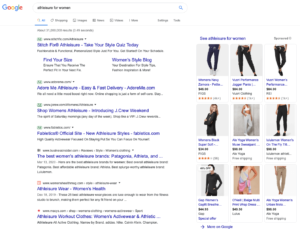Many e-commerce retailers consider their PPC and SEO Marketing strategies to be separate entities. When brands only invest in one at a time, they are even occasionally seen as alternatives to one another.
Of course, this is a tragic mistake as PPC and SEO Marketing strategies are necessary to integrate into one another for a site to reach its fullest potential in the SERPs.
Increased visibility and site authority are achieved through SEO, a technique for boosting a site’s organic traffic. Pay-per-click (PPC) advertising, on the other hand, aims to drive traffic by placing properly crafted and targeted advertisements in major online directories like social media and search engines.

Despite the differences, both have a similar end in mind. Additionally, SEO and PPC tactics frequently depend on one another, providing one another with crucial information to help the other perform better.
To properly comprehend the mutually beneficial link between these two marketing strategies, let’s examine these two strategies in-depth, highlighting their differences and similarities as well as how SEO and PPC contribute to one another’s success.
Table of Contents
How PPC and SEO Marketing Strategies Together to drive business goals
SEO and PPC: The differences
The discipline of search engine optimization (SEO) tries to boost both the quality and volume of traffic that a website receives from search engines like Google or Bing. The production of content, technical optimization, link building, and other similar actions are only a few of the SEO tactics available for enhancing rankings.
PPC advertising, on the other hand, is a type of digital marketing where advertisers pay a set sum each time a customer clicks one of their advertisements.
Even though search engine marketing (SEM) includes both of these strategies, there are some significant distinctions between the two ideas.
First off, sponsored advertisements (typically) show up above organic rankings in search engine results, which are influenced by search engine optimization strategies.

Second, advertisers who drive visitors to their sites through their adverts must compensate them for those visits. The same cannot be said for organic listings that receive clicks after gaining visibility through the use of SEO best practices.
Thirdly, PPC campaigns produce results quickly, whether they are traffic, conversions, or any combination of the aforementioned. The KPIs of a site will probably return to their pre-campaign levels once the promotion is over, though.
Instead, SEO tactics frequently take a while to get traction, and companies may not start to see a return on their investment for many months or even years. However, adjustments tend to be long-lasting and incredibly successful once a company’s search optimization strategy starts to produce results.
SEO and PPC: The similarities
Although PPC and SEO differ from one another in several ways, they also have some clear similarities.
First of all, both strategies work to increase website visitors and frequently hope to increase conversions. The objective is the same whether one accomplishes this through paid channels or through the arduous process of organically moving up the SERPs.
Second, keyword-driven techniques like SEO and PPC are both used. While advertisers do keyword research to find lucrative phrases to bid on and unimportant ones to omit via negative keyword lists, SEOs also examine pertinent terms to understand how to optimize titles, content, technical features, and other crucial on-site aspects.
Let’s examine how combining SEO and PPC is the key to success with search engines now that the distinctions and similarities between these two techniques have been described.
How PPC and SEO help each other
Not only is it true that SEO and PPC frequently work towards the same goals, but they also complement one another and benefit both efforts. PPC helps SEO initiatives by:
Maximizing SERP coverage
A website that uses PPC advertising appears first in the search results, capturing the attention of users.
When combined with SEO efforts, a brand may be able to dominate the SERPs, placing advertisements at the top and organic results below. As a result, the company will also be listed in the organic results if a searcher chooses to ignore the ad area.

This effectively gives websites twice the exposure they would have had just one of these tactics used, boosting the likelihood that users will click through to the brand’s website.
Additionally, the fact that a certain firm is so well-represented in the SERPs gives customers more assurance that the company is a reliable one and offers high-quality goods or services.
Organizations can more efficiently direct prospects to their site and promote consumer interaction by integrating PPC and SEO.
Keyword symbiosis
Keyword optimization is crucial for both PPC and SEO to appear for relevant queries. Businesses need to target the right words and phrases if they want to appear in the SERPs for pertinent searches.
Brands that have been optimizing their websites for search for a while already have access to keyword data that can be used to better target their PPC advertisements.
However, given that results take time to manifest, it can be difficult for people who are new to SEO to assess the efficacy of their efforts. However, because PPC ads produce quick results, advertisers can collect valuable keywords and give that information to SEO teams so that they can optimize web pages for more visibility and traffic.

SEOs can better identify the kinds of terms users are looking for to find a company’s pages by using keyword data from PPC campaigns. Marketers may use PPC data to make the necessary changes to SEO efforts rather than waiting for SEO data to start coming in.
Once SEO results start to appear, PPC advertisers can use that information to improve the effectiveness of their advertisements.
Elevated brand awareness
When a customer clicks on a PPC ad, they are directed to a landing page where they may read more about the company and its products. After then, they might go around a website more thoroughly to acquire a better sense of the brand. In other cases, they can become disinterested and leave the page.
While this can seem a little depressing, the PPC ad only made the consumer aware of the business and what it has to offer. They are likely to recall their encounter with the business’ website and click on its organic listings when they conduct a subsequent search for comparable goods or services.
A brand’s organically listed content is more likely to be engaged with as potential customers become more accustomed to it, which increases traffic and (perhaps) conversions.
Even if potential customers don’t immediately convert, PPC advertising ultimately aids in raising brand awareness for a company, which may eventually result in increased organic traffic.
These are just a few examples of how SEO and PPC complement one another.
This explanation will be useless, though, if business owners don’t know how to track and evaluate this information.
How to track and measure performance
It is a given that every business will have a different set of goals. We will study this topic using the two most typical targets of an online business: traffic and conversions since the KPIs used to measure these goals will differ.
A business’s SEM goals don’t have to be complicated. However, they shouldn’t be overly simplistic, either.
Therefore, goals should cover information like:
There are numerous significant PPC KPIs that marketers should track. The most important ones to track in this discussion, though, are click-through rates and conversions.
Advertising can learn which terms are effective at persuading customers to take the desired action and producing income for a business by analyzing the click-throughs and conversions created by specific keywords.
The SEO department of a company can then be given the keywords that have proven to be most effective for on-site optimization and content production.
Google Analytics will serve as their main tool for tracking the results of optimization work on the SEO front. These people will wish to analyze the following KPIs:
By tracking these metrics with Google Analytics, website owners can determine whether they are using the proper keywords to attract visitors, whether users can find their site using those terms, whether users like their time on the page, and whether visitors are converting as a consequence.
PPC and SEO teams can collaborate to improve the efficiency and profitability of each strategy by measuring and tracking this data.
The main similarity between SEO and PPC is that both strategies are used to advance corporate objectives.
Since these two strategies are inextricably intertwined, businesses must learn how to communicate information between their SEO and PPC teams in order to dominate the competition in the SERPs.

